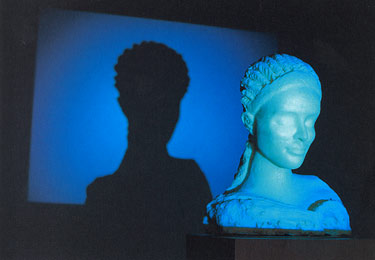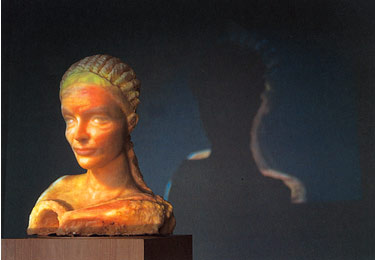| | G.V.E.I.P. | Braunschweig | Hamm | Hannover | Hessischer Landtag | kfw | Luminosa | Schwerte | Parkskulptur | Paderborn |
Museum Wiesbaden | Ars Mundi | Brot und Spiele | Schlachthoframpe | Blaue Blume | Die EUROPAN TOWER | Lichtspieltheater | Fluchttreppe | Porträtinstallationen: | Selbst | Une femme d'Alger | Gunter Göring | Einatmen - Ausatmen | Super - Zuba | Königin von Saba | Pétain als Maler | ESCAPE | Energie-Böxle | Cinemaczz | knusper, knusper... | Interlaken | Pionierwald | |
|||||||
 |
 |
||||||
| R. L. oder die Königin von Saba/R. L. or The Queen of Saba, 1998, Detail der Installation in der Kestner Gesellschaft, Hannover 1998 | |||||||
| R.L. oder die Königin von Saba, 1998 R.L. wird für Kutscher zum Modell der Königin von Saba. Sie ist eine Farbige, die in der Schweiz lebt – eine Lebenssituation, die nicht zur Deckung kommt. R.L. geht zurück nach Äthopien. Kutscher modelliert R.L. als überlebensgroße Frauenbüste mit geschlossenen Augen. Er orientiert sich sowohl an afrikanischen Frauenportraits als auch am zeitlosen Antliz der Nofretete, damit auf die ägyptische Tradition in Äthopien anspielend. Es entsteht eine reale und eine ideale, eine natürliche und eine künstliche Schönheit, die unwirklich und wirklich zugleich ist. Die Wachsbüste stellt er auf einen Drehteller auf hohem Holzsockel. Wachs und Holz sind traditionelle afrikanische Exportgüter. Der Büste gegenüber, auf einem durchsichtigen Plastiksockel, befinden sich ein Videoprojektor und ein Computer. Sieben farbig gefaßte Gipsmodelle der Königin von Saba auf einem Drehteller ergeben das Motiv des Films, der per Videoübertragung auf die Wachsbüste projiziert wird. Die Gipsmodelle repräsentieren sieben verschiedene Alterstufen der Königin, die mit geöffneten und geschlossenen Augen dargestellt ist. Mit der Arbeit wird das Thema von Schönheit und Vergänglichkeit angesprochen. Dem übersteigerten jugendlichen Schönheitsideal stellt Kutscher ein Modell des Alterns in Schönheit und Würde entgegen. Zugleich wird die Darstellung einer farbigen Frau von der üblichen klischeehaften Sichtweise befreit. Die für „Erste Welt“ und „Dritte Welt“ stehenden Materialien bleiben einander gegenübergestellt. Der Betrachter, der sich der Projektion nähern möchte, wird durch zwei Bewegungsmelder daran gehindert. Sprechen sie an, wird die Filmprojektion unterbrochen und stattdessen blaues Licht auf die Büste geworfen. Erst wenn gebührende Entfernung gewahrt bleibt, beginnt der Film erneut. Die Grenzen einer Beziehung werden gezogen. Nähe und Distanz werden als Prozeß von Annäherung und Zurückweichen visualisiert. Peter Forster |
R.L. or the Queen of Sheba, 1998 R.L. became Kutscher's model for the Queen of Sheba. She is a Black woman who lived in Switzerland – a situation that did not work out. R.L. eventually returned to Ethiopia. Kutscher sculpted R.L. as an oversized female bust figure with closed eyes. He drew inspiration from African portraits of women and from the timeless face of Nofretete, thus alluding to the Egyptian tradition in Ethiopia. The work possesses a beauty that is at once concrete and ideal, natural and an artificial, unreal and real. Kutscher placed the wax bust on a revolving disc atop a high wooden pedestal. Wax and wood are traditional African export commodities. Positioned opposite the bust on a transparent plastic base were a video projector and a computer. Seven coloured, framed plaster models of the Queen of Sheba on a revolving disc comprised the motif of the film that was projected by video onto the wax bust. The plaster models represented the queen at seven different ages, with her eyes open in some cases, closed in others. Kutscher's work focuses on the theme of beauty and mortality. He confronts an exaggerated ideal of youthful beauty with a model of ageing in beauty and dignity. At the same time, the representation of a Black woman is liberated from the usual clichés. Materials that stand for the "First World" and the "Third World" remain in juxtaposition. Viewers who wished to move closer to the projected were prevented from doing so by two motion sensors. When these were set off, the film projection was interrupted and a blue light was cast upon the bust. The film did not begin again until the proper distance was restored. Limits were imposed on a relationship. Closeness and distance were visualised as a process of approach and retreat. Peter Forster |
||||||